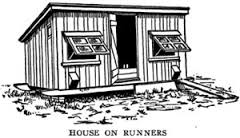April
8, 1937 Mama, John, Henry, and I went to
Meade to get chicks. Mary stayed
home. In the evening H. H. Reimers came
over. It was a cool day.
The Siemens raised their own chicks. They kept some roosters with the hens so that
the eggs would be fertile. In early
spring once it was warm, they would gather about 45-50 eggs, put them in
nesting boxes in a separate brooding house, and set three brooding hens on
them. The brooding house was separate from
the chicken house so that the brooding hens would have a quiet, undisturbed
place to brood on their eggs. They would
put gunny sacks over the windows to darken it.
The eggs hatch in 21 days, but on about day 18, Margaret would take a
bucket of cold water to check if each egg had a live chick. When she put an egg in the cold water, it
would wiggle if it had a live chick in it.
The other eggs they would throw away so that they would not rot in the
nest. Out of 15-16 eggs under one hen,
12-13 would hatch.
 |
| Typical brooding house. |
But a hen could take care of about 20 chicks, even though
she could only brood on 15-16 and only 12-13 would hatch. So they would go to town and buy chicks to
make up the difference so that each brooding hen would have about 20 chicks. Or they might get extra chicks for another hen
or two to take care of.
The chicks would stay in the brooding house for a couple
weeks. When it was warm, they would let
them out on the yard to eat insects, and the hen would watch over them and then
lead then back to the brooding house at night.
Then hens would watch over the chicks for about a month, and then they
would leave the chicks on their own. After
this, they would be moved to the regular chicken house.
Sometimes the fryers were ready to butcher by Cornelius’
birthday on June 15, and they could have fried chicken. But more often it was July before fryers were
ready – because the feed was not as nutritious back then, it took three months
for fryers to be ready. They also
gathered clover along the highway because it was one of their favorite feeds.
In October and November, the chickens stop laying eggs because
the days are getting shorter. Then
Margaret would sort out the hens that did not lay eggs and butcher them. This chicken they would can and use for
chicken noodle soup.
 |
| Nesting boxes for laying hens. The Siemens set the brooding hens in old cardboard boxes. |

No comments:
Post a Comment